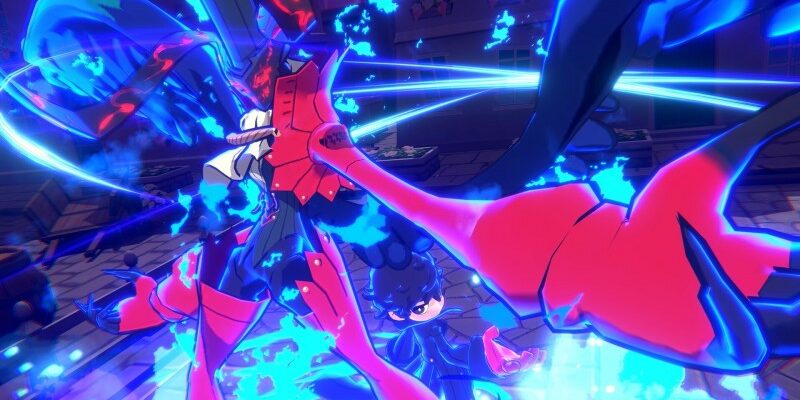Persona 5 has become its own sort of mini-franchise within the Persona series. With many spin-off titles released over the years, such as Persona 5 Strikers, Persona 5: Dancing in Starlight, and Persona Q2: New Cinema Labyrinth, Atlus seems to love using Persona 5’s popularity to explore new stories and gameplay ideas. However, I applaud Atlus for making all of these spin-offs in completely different genres from each other. The latest, Persona 5 Tactica, delivers an entertaining story, a colorful cast of characters, and fun combat mechanics within the context of a strategy RPG. Longtime Phantom Thieves can look forward to an enjoyable side adventure, but its uneven pacing and low enemy variety hold it back from being a true revolution.
Persona 5 Tactica’s story follows the core roster of characters from the original RPG. After finding themselves sucked into an alternate dimension, the group teams up with Erina, the local leader of the Rebel Corps, who wants to liberate citizens from the oppressive rule of the Legionnaires. Toshiro Kusakabe, an amnesiac politician from the real world, also somehow gets swept into the conflict. Their unknown connections to this alternate dimension have enough mystery to keep them interesting throughout the game. As the Phantom Thieves search for a way back home, the antagonists’ motivations intertwine with the origins of these newly introduced characters.
The camaraderie between the cast members can be seen through optional conversations that naturally unlock as you progress through the story. Scenes like these are fun side conversations that allow characters’ personalities to shine, such as Erina’s natural leadership skills after a scene where she feels like a liability, or Ryuji’s role as the comic relief character when a treasure chest he’s seeking turns out to be useless villain-branded merchandise. Viewing these talks also gives the party members GP, which are skill points to be allocated to learn new abilities, so there’s a useful gameplay incentive too.
These conversations are bright and fun to listen to, thanks to the game’s excellent voice acting and art direction. The presentation style is more in line with an exaggerated cartoon style like Persona Q2’s rather than the more realistic proportions like in the original game and Strikers. This helps give Tactica a more lighthearted feel to balance out its darker themes, including illness, death, and trauma. The Persona series is also well known for its music, and Tactica’s soundtrack doesn’t disappoint. The soaring vocals and electrifying guitars will have your head bumping as the Phantom Thieves and Rebel Corp overthrow dictators in battle.
Tactica’s combat is more similar to XCOM than Fire Emblem in terms of strategic battles. Your team of three characters can hide behind cover and gain either partial cover, which drastically decreases incoming enemy damage, or full cover, which provides complete immunity. Tactica cleverly utilizes Persona 5’s main battle mechanics to fit the strategy genre. The most impressive implementation is the franchise’s signature “1 More” mechanic. In Tactica, instead of hitting enemy weaknesses or scoring a critical hit to trigger an additional turn, any unit on the field that isn’t behind cover becomes vulnerable. Being able to chain multiple 1 More turns and extending my movement range each time replicates the same sense of accomplishment that I felt when triggering multiple 1 More turns in the main game.
The 1 More mechanic is even more important when it comes to the game’s side quests. These side quests have restrictions, such as only being allowed to use certain characters or having to complete the battle under a fixed number of turns. I found these to be challenging but also incredibly fun, as they commanded me to think much more strategically than standard story missions. The side missions where I was required to beat them in only one turn were exhilarating.
I had to activate as many 1 More turns as I possibly could while also trying to keep my teammates in a triangle formation. Triangulating on a downed enemy activates Triple Threat, which is Tactica’s version of the RPG’s All-Out-Attacks, where enemies caught in the blast receive massive damage. Mastering these techniques to come out on top of these challenging side missions is rewarding, and they come with an equally amazing prize: Completing them nets you 20 GP as opposed to 2 or 3 when viewing conversations.
However, the gameplay suffers from uneven pacing when it comes to introducing new mechanics. This is especially true during the first 10 hours; you don’t receive the powerful follow-up mechanic until the second chapter. I’m confused as to why these highly effective attacks, which let teammates attack an extra time if you knock an enemy off a higher place, weren’t introduced earlier, as that would’ve kept the early hours fresh.
Enemy variety is also sorely lacking. Much of the time, you end up facing regular enemies with guns that don’t have any special traits to them. There’s also a bigger enemy that can only be downed if you hit it twice. Aside from some unique boss mechanics towards the end of a chapter, new enemy types are introduced sparingly. Enemy variety does improve later on, but not quick enough; it’s usually only a single new one per chapter. As a result, it’s boring to simply go through the motions when you’re repeatedly fighting the same kind of enemies.
Persona 5 Tactica is a fun time for someone who’s looking for a more casual strategy game. The Phantom Thieves are just as charming as ever, and the newly introduced characters mesh well with them. It’s not an essential experience in the same way that Persona 5 Strikers was, but fans who aren’t tired of Persona 5 yet will find plenty to like with Tactica.
Source: Read Full Article
